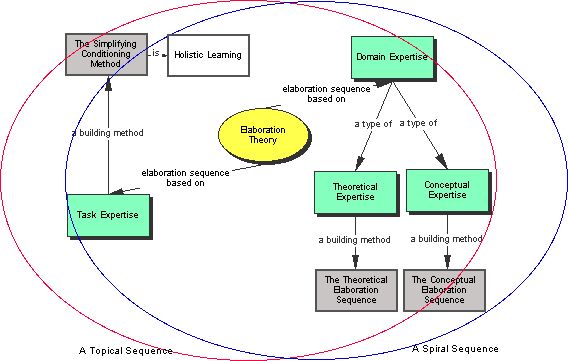Sadržaj
Elaboration Theory
General
Elaboration theory is one of the cognitivist models for instructional design proposed by Charles Reigeluth and his associates in the late 1970s. It was based on the cognitive research findings available at the time and influenced by works of Jerome Bruner (see: discovery learning) and David Ausubel (see: assimilation theory)1). Very well accepted, elaboration theory was offering suggestions on how to organize and sequence different types of instruction on macro level.2) For organizing instructions on the micro level, Reigeluth suggested using Dave Merrill's component display theory.
What is elaboration theory?
The key principle of the elaboration theory is that the content being taught should be organized starting from the simplest and then increasing order of complexity and that learner has to develop a concept in which new ideas will be meaningful and well accepted.
In context of elaboration theory, Reigeluth distinguishes between domain expertise (the process of becoming an expert in the body of knowledge of a more theoretical discipline) and task expertise (the process of becoming an expert in the procedural knowledge of a discipline involving more practical tasks). In order to teach a student to become one of the two, elaboration theory suggests instruction should be organized in the following eight strategies3)4):
- Structure organizing can be conceptual (presenting objects, or ideas with certain common characteristics), procedural (presenting a set of actions in order to accomplish a goal) or theoretical (presents theoretical aspects, causes and effects). Selected organizing structure must reflect course's main focus. According to Reigeluth, every course holds one of this three to be more important than the other two.
- Sequencing content5) in increasing order of complexity. Course should be started with the most basic and more complex ones should be built on them.
- Within-lesson sequencing can regardless to the organizing structure be topical (topic is studied in depth before moving to the next one) or spiral (firstly all topics are briefly introduced before going into details about each of them). Sequencing content within a lesson with respect to the selected type of organizing structure should:
- for theoretically organized instruction present ideas from simple to complex,
- for procedures present steps in their order of appearance, and
- for conceptually organized instructions start from more familiar and general concepts.
- Summarizers (content reviewers) presented as a learned rule followed by example and practice materials.
- Synthesizers (diagrams, images or other) to enable easier meaningful integration and assimilation of new knowledge into existing knowledge.
- Analogies to enable easier relation of new knowledge to prior knowledge.
- Cognitive strategy activators in terms of images, diagrams or simply directions to mentally represent learned content.
- Learner control can also increase effectiveness of learning. Reigeluth suggest learners should practice control over instructional strategies and content.
Criticisms of the elaboration theory resulted in a new more holistic approach presented by Reigeluth in 1992, called simplifying conditions method (SCM). In simplifying conditions method Reigeluth suggested instructional designers should “work with experts to identify a simple case that is as representative as possible of the task as a whole”6). This representative would serve as an epitome of the course.
Criticisms
The first criticism of elaboration theory applies to the fact that it is more a model or a design procedure than a learning theory. It has been suggested7) elaboration theory should be reformulated into a set of principles more related to the very process of learning.
Other criticisms of this theory come from distinguishing between only three different knowledge types (theories, procedures and concepts). This is a simplifying design constraint, yet there are surveys8)9)10) that resulted in different, sometimes significantly larger number of knowledge categories.
Another critic of this theory bases on the used assumption that most general concepts are always closest to learner's prior understanding, which has shown to be unfounded by Wilson and Cole11), especially in case of an ill-defined learning domain.
Keywords and most important names
- Elaboration theory, domain expertise, task expertise, content sequencing
Bibliography
Elaboration Theory (Reigeluth) at Learning Theories. Retrieved March 11, 2011.
TIP: Elaboration Theory (C. Reigeluth). Retrieved March 8, 2011.
Ho, Weny. Reigeluth's Elaboration Theory. Pennsylvania. Retrieved March 11, 2011.
